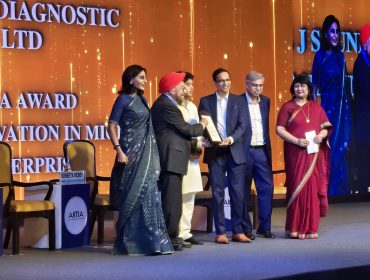
Challenges & Opportunities of Digitization for SMEs – Asian perspective
BANGKOK (THAILAND), November 23th-28th, 2016 – The Asian SMEs continue to face problems in their day to day operations such as inadequate infrastructure and credit facility, recruitment of skilled labour, lack of targeted marketing strategy and distribution channel, low technology penetration etc. They had to face competition from large firms not only in their own country but also from the companies abroad and massive imports. With the onset of third industrial revolution challenge to digitize, it is crucial for Asian SMEs to take adequate measures to retain its existing status and emerge as global leaders. In order to make Asian SMEs globally competitive and successful, it is necessary for them to innovate and become innovative and technology savvy with enrichment of skills of existing workers with the onset of the digitization.
1. Technology as a game changer
With digitization in industry – a Third Industrial Revolution has set in motion. The first revolution started in Britain with the mechanization of the textile industry, where instead of crafting things by hand, machines were used to make them. The second revolution began in America which led to the period of mass production with the concept of assembly line. And now, in the third industrial revolution, the future of manufacturing will be digitized with everything in the factories being run by smarter softwares. According to The Economist, the traditional systems of manufacturing products will be replaced by the highly automated group of machines. Factories will be becoming vastly more efficient with automated machines that can swap and cut tools, visualize and have other sensing systems with robots equipped within them. The effects of digitization in manufacturing will not only be limited to large manufacturers but tremors will be felt by Small and Medium Enterprises also in Asia. The consequences of all these changes will have a big impact on the Small and Medium Enterprises (SMEs) in the developing countries like India, China, Thailand, Malaysia, South Korea, Taiwan and other Asian countries as this digitization will encourage makers to shift some work and jobs back to the rich and developed countries like USA and Europe. The modern and digital manufacturing processes like the 3D printing will allow things to be made more economically, flexibly and with less labour. This will empower small and medium firms and individual entrepreneurs. Mass manufacturing will turn towards more individualized production. However, we must recognize that SMEs have to be empowered to face the onslaught of imports and global competitiveness. Technology will enable the process of empowerment of SME to upgrade their technology to produce quality products at competitive prices and face the global competition. Technology could be a game changer for SMEs.
SME segment is not unified but much diversified. Its presence is felt across traditional sectors such as agro-based products to the newly evolved e-commerce retail industry. Truly competitive SMEs have to be agile, get close to customers and be constantly innovative. Technology is a keen enabler of innovativeness in SMEs. The arrival of broadband, smart phones and the eager adoption of mobile-based technologies have empowered small business to address competition and demand for quality in a globalized and knowledge based economy. While huge disparities still exist in the nature of knowledge tools adopted, SMEs are transitioning towards addressing some challenges with information and communication technologies (ICT). ICT is changing the way small enterprises engage their customers and run their back-office processes. Computerization has helped cut costs by streamlining internal processes, improving services through faster communication with customers, and bettering promotion and distribution of products. Every link in the value chain is empowered. Hence, there is no escape for SMEs but to upgrade their technology, products, processes, marketing techniques and organizational toning.
2. Fostering of Innovations In SMEs:
According to a well known management thinker and Guru Peter Drucker, Innovation is an essential process of change that is necessary in order to maintain the development and growth of an enterprise . Innovation is defined as the ability of an enterprise to “manage knowledge creatively in response to market-articulated demand and/or other social needs” (OECD, 1999).
The concept of innovation adopted in the survey as in the OSLO Manual and adopted by NIOS according to which `any product development that results in generation of wealth is regarded as Innovation`. The `product development` as further elaborated in `Oslo Manual for measuring innovation` would include not only product development per say but also novel processes, strategies, changing or leading to benefits/gains to the firm. Thus as per the Oslo Manual there are four types of innovations namely;
(i) Product innovation
(ii) Process innovation
(iii) Marketing innovation
(iv) Organizational innovation
Keeping in view the above definition, we carried out a study on
‘Status, systems and strategies of innovation in SMEs in the equipment and machinery sector’ on behalf of the Department of Science & Technology, Government of India with the purpose to identify trend of innovation in the SMEs. The study focused on the novel developments/innovations done by the SME firms in terms of the products, processes, marketing strategies, organizational changes made which have enhanced product(new product),productivity, efficiency, market reach etc. leading to the gains to the firm, industry and country at large. The equipment and machinery firms in the SME sector have innovated products to suit the locale specific conditions in the resource constrained environment that hitherto prevailed in India, by frugal use of scarce resources. Affordability, appropriability and sustainability of Indian SME equipment and machinery manufacturers have replaced the premium pricing and abundance use of resources generally associated with imported equipments. It has been found in the comprehensive study that innovations by SMEs are mainly by way of introduction of machinery and equipment which are new to the firm albeit adapted by reverse engineering with minor modifications/improvements, of the existing machinery and equipment produced by others or imported.
The Study shows innovations for most participating SMEs meant adapting others’ basic designs with minor modifications undertaken mainly though their in-house efforts. However, it was heartening to note that a few owner-innovators do recognize the need for innovating novel products, not only new to the firm but even globally and working in this direction. Though the nation has invested heavily in creating scientific and technological infrastructure by way of publicly funded R & D laboratories/institutes, Universities, Polytechnics etc, however, it was surprising that the SMEs were largely not aware of their expertise, facilities and knowledge assets or avers to availing of their assistance owing to bureaucratic attitude, failure to maintain delivery schedules, inadequate contemporary knowledge of the specific sector etc.
As mentioned earlier, fostering of innovation in SMEs is crucial for their growth and development. Hence, SMEs need to be encouraged to innovate and for which awareness and financial incentives are required.
3. Skill Development of Asian SMEs
SMEs provide the largest share of employment after agriculture in Asia and have the potential to provide jobs to teaming millions of unemployed youth. Strengthening the roots of SME will foster the economic growth which can be enriched through the skill development programme.
The unavailability of desired labour lengthens the job matching process, with candidates facing difficulties in finding jobs that match their skill-set and with employers struggling to find workers with suitable skills. The problem is particularly acute for small and medium sized firms since they require fewer employees, it is expensive for them to invest heavily in recruitment processes, and it is not feasible for them to set up captive skill-training institutes. In the short-run, this skill gap leads to loss of productivity. In the long-run, this demand-supply gap may adversely affect economic growth. However, should the low availability of skilled labour persist, employers are likely to substitute labour with technology by automating processes. Hence, the lack of skill development will prevent inclusive growth for the economy in the long-run.
There is no simple solution to find skilled persons for SMEs and has to be found in the Asian context to meet the needs of SMEs. Some experts have advocated and cited the example of Germany and other European countries for the success of their apprenticeship program. Their strong institutionalized apprenticeship training programme or the dual education system which implies a candidate has to register with a business or a company where apprenticeship training can be completed. The dual system means apprentices spend about 50 -70% of their time in companies and the rest in the formal education with an institution. Depending on the profession, they work for 3-4 days a week and then spend 1 or 2 days at vocational training schools.
It is desirable that the apprenticeship programme should be extended to small and medium enterprise, which could provide on-the-job training to the unskilled persons in their factories and 50% of stipend or salary should be reimbursed by the government with maximize duration of one year. This will give incentive to SMEs to employ and train unskilled labour and will be a boon for generation of employment in the country. In addition, the skills of the employees in the factories could be upgraded through formal and theoretical training programme in the classroom during the evening hours or on Saturdays / Sundays to enhance their productivity and quality consciousness as part of quality management. This practice has been successfully tried and implemented in South Korea where productivity levels have gone up very high.
HRM practices are invariably implemented in the large industries. Human Resource Management practices should also be adopted in the SMEs to get employees involve in their jobs. It focuses on “high skill” strategies that make better use of and continuously renew human capital. It covers a range of personnel management areas including performance-based pay, job rotation, flexible job designs, employee involvement, skills training, and communication procedures. Hence, SMEs regardless of their size, should implement innovative HRM practices. There are fundamental skills related to productivity, entrepreneurship and green skills should become foundation skills sets for SMEs with local customization.

Conclusion
It has been seen in various Asian countries such as China, India, Malaysia, Thailand and most of the European Union countries, SMEs are the major contributor for their growth. In order to achieve this milestone, small & medium enterprises in manufacturing sector of India require a combination of success factors and have to learn from developed countries. The utmost need to make SMEs competitive which can be achieved through capacity building of SMEs in managerial skills, professionalizing them and need based training on management of enterprise. Technology, innovation and skill development of SMEs should be given priority to make them competitive.
In my capacity as Vice President of WUSME, I have the honor to convey the very best greetings and wishes of WUSME’s President Dr. Gian Franco Terenzi. WUSME, the World Union of Small and Medium Enterprises is an International Civil Society Organization with Headquarters in the Republic of San Marino with Representatives in more than 70 Countries worldwide. Under the President’s competent direction, in 2012 WUSME has become partner organization of UN Global Compact and reached, in 2013, the Special Consultative Status at United Nations Economic and Social Council – ECOSOC.
WUSME is presently the one of the primary SMEs supporting Civil Society Organization at the UN and, as such, a bridge for its member associations to the United Nations.
Written by WUSME Vice President
Dr. J.S. Juneja
Related Post
WUSME Partner of the AIM Congress...
WUSME participated in the 14th edition of the ANNUAL INVESTMENT MEETING Congress (AIM Congress 2025), held in Abu Dhabi from 7 to 9 April ...
WUSME’s contribution to the Dr. Juneja...
Within the scope of the ongoing fruitful collaboration between the AIMA (All India Management Association) and the WUSME, President Barbara ...
WUSME General Meeting 2025 remembering Gian...
On the occasion of the annual General Meeting, WUSME reminds that May 20th marks the fifth anniversary of the demise of GIAN FRANCO TERENZI,...





